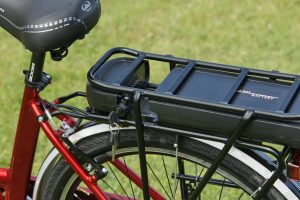Cycling in the Rain

Cycling in the rain is a fact of life that almost every cyclist has to deal with at some point. When that happens it’s easy to think “Not today….. I’ll give it a miss / take the car / stay home” etc.
However, with a little preparation and forethought, there’s absolutely no reason not to cycle in the rain. Indeed for many people, their bicycle is the only way they have of getting to work or school etc so cycling in the rain is their only option.
By utilising the tips below cycling in the rain should be almost as easy as cycling in the dry.
Get the right clothing.
The most obvious thing to do is make sure you have the right clothing for cycling in the rain. This will vary quite a lot depending on the type of cycling you’re doing.
Upper Body—If you’re on a training ride for a race, etc., then you’ll need a light waterproof jacket that sits over your normal jersey. These are generally very good for waterproofing in light to medium rain but not necessarily all that good in a heavy downpour. If you’re commuting or leisure cycling, etc., then a rain cape that not only covers you but also the handlebars might be a much better idea.
Hands and Feet: Wet hands and feet are a surefire way to turn an otherwise fine ride into a horrible ride. A bewildering array of gloves, overshoes and socks are on the market. Our best advice is to stick to tried and tested brands such as Sealskinz or Stolen Goat. Neoprene will help to keep your hands or feet warm although it is only water resistant rather than waterproof. Rubber overshoes or boots provide better protection but aren’t as breathable so may cause you to sweat more.
Head – Keeping your head dry is probably one of the hardest things to do. If you’re a helmet wearer then waterproof covers are available. Twinning that up with a peaked casquette will keep the worst of the rain off your head and face. Adding a snood or buff will stop any drips running down your neck.
Eyes – it may seem obvious but protecting your eyes is crucial in the wet. Road spray is usually laden with all manner of dirt and grit. Your eyes are not replaceable so look after them. If you don’t need prescription glasses then lightweight industrial safety glasses are a good cheap option. If you have a prescription then wrap-around sports glasses with a prescription insert can be cheap. They also usually come with a range of lenses for different light conditions.
Obviously, any winter clothing should also be as bright as possible to increase your visibility to other road users.
Maintain your bicycle
The muck and rubbish thrown up from the road will affect the running of your bike. Geartrain components covered in dirt, grit, and grime (and salt if it‘s winter) will wear out much quicker. Also, grease can be more easily washed out of bearings in wheel hubs and bottom brackets when subjected to large amounts of water spray. One area that many cyclists neglect in the wet is the tyres. Debris sticks to wet tyres much more and can easily become embedded in the tyres working their way through to the inner tube and causing a puncture. So regular inspection for stones etc is important.
Regularly cleaning your bike not only keeps it running smoothly it also helps you spot potential issues much more easily.
Once you’ve cleaned the bike thoroughly don’t forget to lubricate the chain and other essential moving parts
’Winterise‘ your bike
Whilst maintenance and cleaning will keep your bike running smoothly some preventative ‘wintersing’ will also help to keep things running smoothly.
The most obvious winter modification is to fit mudguards. Fit the longest mudguards you possibly can. This will not only protect the bike from muck thrown up by your wheels, it will protect the rider and other nearby riders too. Indeed many clubs insist on mudguards during the winter months
Another relatively easy winter modification is fitting different tyres. A tyre with a little more tread will help to dispel water and increase grip. As we mentioned above, tyres are more puncture prone in the winter so a tyre with some built in puncture protection might help you avoid having to deal with a puncture in the pouring rain. We particularly like the Specialized Armadillo tyre. If there’s absolutely one maintenance task you should learn for the wetter weather, changing a tube should be it.
The more adventurous riders might want to explore the concepts of tubeless tyres and chain waxing for the winter but that’s beyond the scope of this article.
Whether you run lights all year round or not, running lights in the wet is a very good idea. If you’re on the road then spray from other road users will form a mist. This will impede visibility so a bright light front and rear can do no harm in helping you stand out.
Adapt your riding style
Unless you’re in a race or training for such it’s advisable to adapt your riding style in wet conditions.
Simply slowing down a little will give you an extra second or two reaction time should anything happen. Corners are a bit more tricky and slippery in the wet. Being a bit more cautious when tackling corners is a definite must.
Avoid Puddles – As children, we all loved to ride through puddles and create a splash but it’s actually a pretty risky activity. Puddles naturally form where there is a dip in the ground, and as most will be filled with dirty water it’s usually impossible to see how deep they are. Sure it might only be a small, smooth, depression but it could just as equally be a deep, steep-sided pothole capable of breaking a wheel, bike, or even rider. If nothing else, all you’re going to do is cover your bike in dirty water, road muck and debris.
Have Spare Clothing
If you’re cycling for commuting purposes, or to school/college etc then either have a spare set of dry clothing at your destination or carry a spare set with you. It’s no fun being sat at a desk all day in damp clothing. You’ll end up smelling like a wet dog and your colleagues won’t thank you for that.
If keeping some spare clothes at your destination isn’t possible then you will have to carry your spares. Assuming you have a bicycle with a rear rack then invest in some good quality waterproof panniers to carry your stuff in. If you don’t have a rack then a waterproof rucksack may be your only option but these can get uncomfortable on longer commutes and may get in the way of a waterproof jacket etc.
In short, cycling in the rain needn’t be a chore or trial. Just make sure you prepare for the conditions in advance and equip yourself properly.








